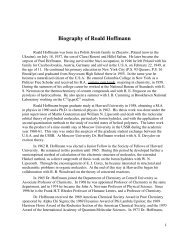Fijian-English Dictionary - eCommons@Cornell - Cornell University
Fijian-English Dictionary - eCommons@Cornell - Cornell University
Fijian-English Dictionary - eCommons@Cornell - Cornell University
Create successful ePaper yourself
Turn your PDF publications into a flip-book with our unique Google optimized e-Paper software.
FIJIAN – ENGLISH DICTIONARY R. GATTY<br />
take on highly varied coloration. Like the tree frog, it has no tadpole phase of growth, differing in this<br />
from the introduced toad, or many frogs in other lands. Tiny young frogs emerge directly from the<br />
large eggs. Neither frog is equipped to live in the water, and the skin membranes between the toes are<br />
minimal. Unlike the tree frog, the ground frog has no adhesive sucker pads on its feet. Both types of<br />
frog were significant items in the diet of Viti Levu highlanders. Syn. dreli.<br />
boto 2. n. toad, Bufo marinus, native to South America, introduced from Hawaii in 1936 with the<br />
misguided notion it would control insect pests in the canefields. In fact, it has become a dreadful<br />
nuisance. Poison glands at the side of the neck repel potential enemies. They exude a while fluid that<br />
can seriously irritate human skin. They are ground feeders, very probably competing with the Fiji<br />
ground frog.<br />
boto 3. n. (Eng.) punt, a European-style boat, often flat-bottomed, usually 16-18 feet in length, often<br />
made of the timbers bauvudi, mavota or dakua, propelled by poling or by outboard engine. Now often<br />
made commercially of fibreglass with more rounded bottom. This has been a common form of local<br />
transport on major rivers and at seaside. At sea, it has replaced the sailing cutters of earlier years,<br />
having the advantage of an engine. In deeper river areas the boto has replaced some of the bamboo<br />
rafts bilibili.<br />
boto-na n. bottom (not of a person's backside), underside. na boto ni yava-na the bottom of his/her<br />
foot/feet. ena boto ni tuvatuva at the bottom of the class (classification, arrangement), boto ni kato<br />
bottom of the kato box/basket, boto ni sauloa bottom of the sea, boto ni ituitui end of the string (of<br />
something, such as small fish). boto ni drau ni pepa bottom of the page.<br />
botoboto pure. kai Idia botoboto pure Indian person (not mixed breed).<br />
botoilevu abrupt, abruptly; rapid, unpleasant or unfortunate termination. Sa tini botoilevu. It ended<br />
abruptly. curu botoilevu v. to enter (or depart) brashly, without proper protocol (as many Tongans<br />
were thought to have done in early years.) Syn. curu botolaki.<br />
botolaka v. to heave out or down.<br />
botolaki adv. roughly, crudely, without showing proper respect, as in curu botolaki to enter/exit without<br />
proper courtesy. Syn. botoilevu.<br />
botonikete-na n. lower abdomen.<br />
bou (Polyn. pou) n. central house-post; appears in some place names Nabouwalu eight house-posts,<br />
Naboutini ten house-posts. Such words are used for place-names, indicating what was originally a<br />
Tongan settlement.<br />
boulu (Eng.) n. bowl.<br />
bouta (Archaic) n. a function of certain clans only in certain parts of Fiji, special service for the chief,<br />
usually the duty to bury him when dead. Clans often have a traditional function, such as fishermen<br />
(gonedau), spokesman for the chief (matanivanua), warrior (bati), priest (bete), empowering the chief<br />
(na sau), and bouta, occasionally spelled bauta. The functions are maintained usually with appropriate<br />
ceremony. The divisions are more elaborate in coastal areas of Polynesian influence and less elaborate<br />
among tribes in the interior of Viti Levu.<br />
bovu n. a well known common shrub or small tree, much used as a general digestive medicine for babies,<br />
and to help control overheating of a baby; Mussaenda raiateensis, formerly M. frondosa. Tiny yellow<br />
flowers subtended by very large sepals that look like huge white petals. One uses the inner bark of<br />
stem or branch and the leaves. Syn. vobo. (West, Bua, Macuata) bobo.<br />
bovoro v. to crush open, crack (as of a nut).<br />
bowai (Archaic) n. type of pole-shaped fighting club.<br />
bowiri dizzy, faint standing up. wiri suggests spinning.<br />
bu 1. n. coconut at the drinking stage, with a very small amount of gelatinous flesh. bu sosou bu with<br />
little or no flesh to eat. kabata na bu climb up for the bu. la’i kaba bu mai. go climbing to fetch<br />
down bu. vakavidika na bu. tap, snap the fingers against the bu to test it. sau, sauca na bu to cut or<br />
pierce the bu for drinking. diri, dirika na bu crack the top off the bu. vida, vida na bu split,<br />
cleave open the bu. See drokai for coconut with gelatinous flesh but also drinkable liquid.<br />
Idiom: bu ni Bau a poor substitute (because Bau has so very few coconuts that one could never<br />
obtain a fine drinking-nut at the right stage of maturity).<br />
bu 2. n. form of address for grandmother (father’s mother). Syn. bubu. (Lau) pu, pupu. bu levu great<br />
grandmother. bu-na n. grandmother.<br />
bua 1. n. Tahiti gardenia, Gardenia taitensis, Rubiaceae, indigenous in Vanuatu, Fiji, Tonga, probably<br />
Samoa, aboriginal introduction to Hawaii. The name is tiare from French Polynesia where it is the<br />
national flower of Tahiti. Flower usually white, propellor-shaped, delightful scent. pua is an ancient<br />
Polynesian name meaning “flower”, and sometimes refers to certain specific flowers in the various<br />
28

















